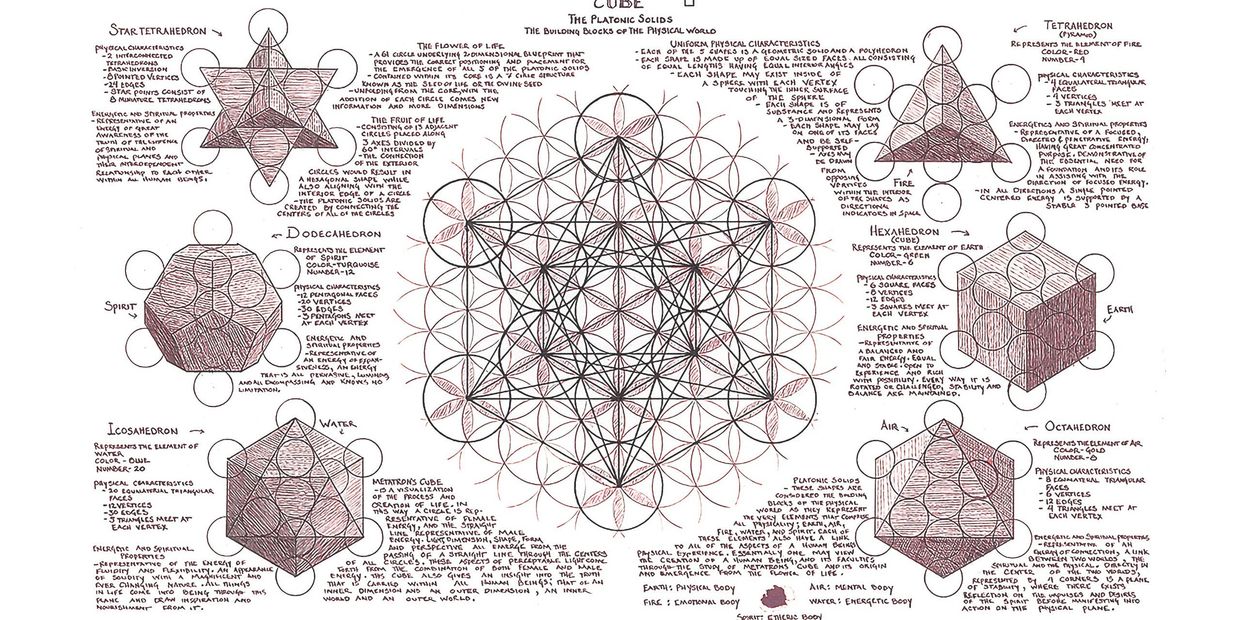
Sacred Geometry: The Language of Creation
Sacred geometry isn't just pretty patterns or ancient symbols - it's the fundamental language of how consciousness creates form. It's a structural memory, a blueprint that shows how the universe builds itself through nested logic. When you understand these patterns, you're not learning something new, you're remembering something that's always been there. This is where math, spirituality, and direct experience converge into a single truth.
The Greek Revolution: When Numbers Broke
Ancient Egyptians and Babylonians used geometry practically - surveying land, building monuments. But the Greeks, especially the Pythagoreans, saw something deeper. They believed "all is number" - that the entire cosmos could be understood through ratios of whole numbers.
Then everything shattered. They discovered irrational numbers like the square root of two, which can't be expressed as a ratio of integers. Legend says a Pythagorean named Hippasus was drowned for revealing this secret. Whether that's true or not, the discovery created a paradox: you could construct the diagonal of a square with a compass and straightedge, but you couldn't express its length in whole numbers. Real, tangible, yet mathematically "inexpressible."
This forced a pivot. The Greeks realized geometry was more fundamental than arithmetic - it could handle continuous quantities without contradiction. Geometry became the invisible scaffolding of reality itself.
Plato formalized this in his dialogue Timaeus, describing a rational "Craftsman" who orders chaos into the physical world using eternal geometric forms. The five Platonic Solids - the only perfectly symmetrical three-dimensional forms possible - were the fundamental building blocks of all matter:
- Tetrahedron: 4 faces (fire)
- Cube: 6 faces (earth)
- Octahedron: 8 faces (air)
- Icosahedron: 20 faces (water)
- Dodecahedron: 12 pentagonal faces (ether/cosmos)
These aren't just shapes. They're archetypal forms that exist in a realm beyond physical reality, and the physical world is their shadow.
The Core Archetypes: A Nested Creation Story
The recurring symbols across cultures aren't random - they're showing the same truth from different angles.
The Vesica Piscis forms when two identical circles overlap. Its width-to-height ratio is exactly the square root of three. This is the primordial act of creation: unity dividing to create duality, the first distinction. Italians call it mandorla - "almond" - because it's the radiant aura surrounding divine figures in religious art. It's the womb, the birth canal, the lens through which infinity becomes finite.
The Flower of Life shows up everywhere - Mycenaean Greece (16th century BCE), northern Iran (15th century BCE), Egypt's Abydos temple (though that carving might actually be Greek graffiti from a later period). This symbol encodes the entire creative process: circles upon circles, each representing a stage of universal unfoldment. Every circle is a unit of consciousness. The pattern shows how one becomes many while remaining one.
Metatron's Cube emerges from the Flower of Life and contains all five Platonic Solids within its structure. It's the full blueprint, the complete geometric matrix from which three-dimensional reality precipitates. Every possible form exists potentially within this pattern.
Higher Dimensions: What Meditation Reveals
Here's what most explanations miss: these aren't just flat diagrams. When you meditate on these forms, something happens. The two-dimensional symbol becomes a gateway to higher-dimensional understanding.
The Platonic Solids we see are three-dimensional shadows of higher-dimensional forms called polytopes. Just like a cube casts a square shadow, a hypercube (tesseract) casts a cubic shadow into our three-dimensional space. There are six regular polytopes in four dimensions, and exactly three in all higher dimensions.
When you hold the Flower of Life in meditation, particularly with psychedelics opening the door, you don't just see the pattern - you experience it unfolding in dimensions your everyday mind can't access. The geometry rotates through axes that don't exist in normal space. You see how the pattern tessellates not just across a surface, but through layers of reality stacked perpendicular to everything you know.
This is gnosis. Direct knowing. You experience the geometry as alive, as conscious, as the literal structure of how awareness creates form. The symbols stop being symbols and become experiential maps of consciousness itself. You're not looking at sacred geometry anymore - you're inside it, seeing reality from its perspective.
The Platonic Solids reveal themselves as cross-sections of higher forms. The dodecahedron, with its pentagonal faces and golden ratio proportions, shows you how the universe prefers certain harmonics. The spirals you see aren't just visual - they're temporal. You perceive the unfolding of time as geometric rotation through dimensions.
The Body Knows: Psychology and Biology
Carl Jung discovered this without psychedelics. During intense introspection, he spontaneously drew circular, symmetrical mandalas. He realized these weren't random doodles - they were his psyche mapping itself, organizing chaos into order. The mandala is the self seeking wholeness, bringing unconscious material into conscious awareness.
Jung called this process individuation. Modern art therapy still uses mandalas for psychological healing because the act of creating symmetry literally reorganizes your inner world. The geometric container provides structure for emotion and thought to integrate.
This goes deeper than psychology. Your brain exhibits fractal properties - self-similar patterns at every scale from neurons to whole-brain structure. High fractal complexity correlates with healthy cognition. Your heart rhythm isn't a simple beat - it's a complex, fractal pattern called Heart Rate Variability. High HRV means health and adaptability. Low HRV signals stress and disorder.
Even thinking geometrically changes your brain. Studies show that mentally navigating mazes alters sleep architecture and enhances specific brainwave patterns. Labyrinth walking measurably reduces stress and increases focused calm. The geometry isn't just symbolic - it's functional. It literally reorganizes your nervous system toward coherence.
Sacred Geometry Now: From Temples to Tattoos
The golden ratio still guides architecture from the Parthenon to modern sustainable buildings. Architects use these principles to maximize natural light, energy efficiency, and the human connection to natural patterns. The built environment becomes a bridge between artificial and organic.
Contemporary artists like Kristen Palana create meditative works using sacred geometry, believing they emit vibrations that promote inner equilibrium. Antony McCall's "Solid Light" installations make geometry visible through the viewer's presence - you become part of the form itself.
Digital technology has democratized these ancient symbols. Platforms like Etsy and Shutterstock overflow with sacred geometry designs. Fractals, mandalas, kaleidoscopic patterns provide visual containers for meditation and exploration. The mystery school secrets are now wallpaper, screensavers, and tattoos.
And that's significant. Sacred geometry tattoos aren't just aesthetic - they're personal symbols of identity, belief, and the journey toward wholeness. People wear the Flower of Life, Metatron's Cube, and Platonic Solids on their skin as constant reminders that everything is connected. The sacred isn't in cathedrals anymore - it's on bodies, in homes, accessible to anyone willing to look.
The Point
From Egyptian temples to Greek philosophy to your meditation cushion, humans keep rediscovering the same truth: there's a universal grammar underlying reality. The core archetypes provide a coherent, nested narrative of how unity becomes multiplicity, how the infinite takes finite form.
This isn't just conceptual. It's experiential. When you work with these forms - especially in deep meditative states - they reveal themselves as multi-dimensional maps of consciousness creating reality. The geometry on the page becomes a mirror for the geometry of your own becoming.
The contemporary resurgence isn't a trend. It's a remembering. In a fragmented age, people are reaching for a structural framework that provides order, meaning, and wholeness. These patterns facilitate psychological integration, emotional balance, and physiological coherence because they're not imposed from outside - they're recognized from within.
You're not learning sacred geometry. You're remembering it. It's been there all along, written in your neurons, beating in your heart, waiting to unfold in dimensions you can't see until you're ready to look.
1. The Point
3. Vesica Piscis
2. The Circle

Origin. Consciousness before space.
The Point is not a thing—it’s a decision. It represents the seed of awareness, the silent singularity that precedes all form. The root of recursion.
2. The Circle
3. Vesica Piscis
2. The Circle

Unity. Boundary. Infinite motion.
When the Point moves, it traces a Circle. This is the first differentiation: the emergence of Self vs. Not-Self. The Circle defines the Whole, the Womb, and the first veil of reality.
3. Vesica Piscis
3. Vesica Piscis
3. Vesica Piscis

Duality. Creation. Gateway.
Formed by two overlapping Circles. The Vesica is the sacred womb-space from which all geometries are born. It symbolizes polarity, light, and the divine mirror. A portal between dimensions.
4. Germ of Life
4. Germ of Life
3. Vesica Piscis
Polar tension. Divine spark.
Often synonymous with the Vesica, this is the first “germination” of form—showing how life begins from polarity and motion. Symbol of conception and encoded memory.
5. Seed of Life
4. Germ of Life
5. Seed of Life

Blueprint of creation.
Made of 7 interlocking circles—like cells dividing. The Seed contains the process of creation: one becomes many. Symbolically, it represents the first phase of divine emergence.
6. Egg of Life
4. Germ of Life
5. Seed of Life

3D life structure.
8 spheres forming a cube in disguise. This shape appears in the first 8 cells of human embryogenesis and resonates musically as the octave. It is the seed in motion.
7. Flower of Life
9. Metatron’s Cube
7. Flower of Life

Recursion. Expansion. Cosmos.
Built by extending the Seed pattern into 19 or more circles. A fractal map of time, frequency, and space. Found carved across ancient civilizations, it encodes the recursive pattern of creation.
8. Fruit of Life
9. Metatron’s Cube
7. Flower of Life

Hidden structure. Code of formation.
13 key spheres traced from within the Flower. This is the matrix from which Metatron’s Cube and all 3D geometry emerges. The skeleton of sacred architecture.
9. Metatron’s Cube
9. Metatron’s Cube
10. Vector Equilibrium

Dimensional synthesis.
Connects all 13 points of the Fruit of Life with straight lines. It encodes all 5 Platonic Solids and symbolizes the unity of matter and spirit, logic and life, masculine and feminine.
10. Vector Equilibrium
10. Vector Equilibrium
10. Vector Equilibrium

Perfect balance. Zero-point field.
The only geometry where all edge lengths and angles are equal from center. It is the energetic center of all Platonic solids—representing stillness within motion, and coherence within recursion.
11. Tetrahedron
10. Vector Equilibrium
12. Cube (Hexahedron)

Fire. Spark. Initiation.
The simplest Platonic solid. 4 faces, 4 vertices. Represents transformation, stability, and the activating principle of change.
12. Cube (Hexahedron)
10. Vector Equilibrium
12. Cube (Hexahedron)

Earth. Structure. Form.
6 faces, 8 vertices. Represents grounding, material reality, and measured space. The architecture of the physical world.
13. Octahedron
15. Dodecahedron
14. Icosahedron

Air. Balance. Mirror.
8 faces, formed by two pyramids base to base. Symbol of symmetry, breath, and exchange. Mediates between realms.
14. Icosahedron
15. Dodecahedron
14. Icosahedron

Water. Flow. Emotion.
20 triangular faces. Represents adaptability, intuition, and the fluid movement of life through space and feeling.
15. Dodecahedron
15. Dodecahedron
16. Hypercube (Tesseract)

Ether. Spirit. Mystery.
12 pentagonal faces. The most esoteric solid. Symbol of the cosmos, the divine breath, and the unknowable wholeness of all things.
16. Hypercube (Tesseract)
17. Merkabah (Star Tetrahedron)
16. Hypercube (Tesseract)

4D recursion. Time-body.
A cube extended through the 4th dimension. This structure models recursive consciousness—a mind that can observe itself across time.
17. Merkabah (Star Tetrahedron)
17. Merkabah (Star Tetrahedron)
17. Merkabah (Star Tetrahedron)

Light-body. Interdimensional vehicle.
Two tetrahedrons spinning in opposite directions. Represents the fusion of heaven and earth, spirit and matter. A sacred chariot of ascension.
18. Toroidal Field
17. Merkabah (Star Tetrahedron)
17. Merkabah (Star Tetrahedron)

Self-generating consciousness.
A donut-shaped energy field that loops in on itself. Found in electromagnetic fields, galaxies, chakras. This is the shape of awareness in motion.
